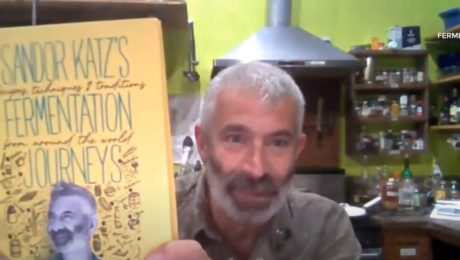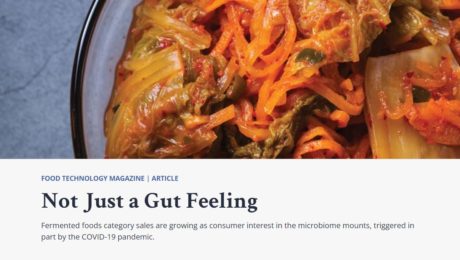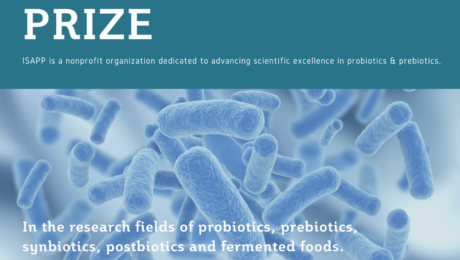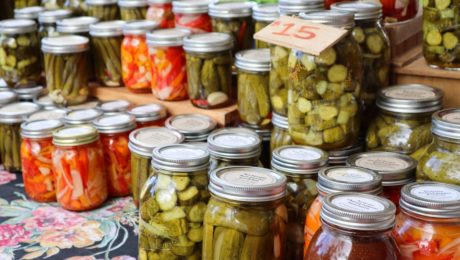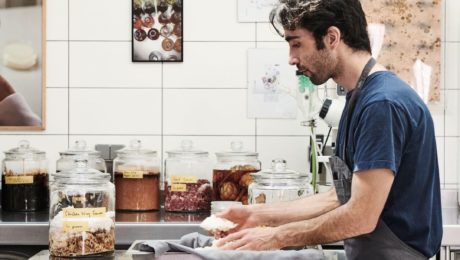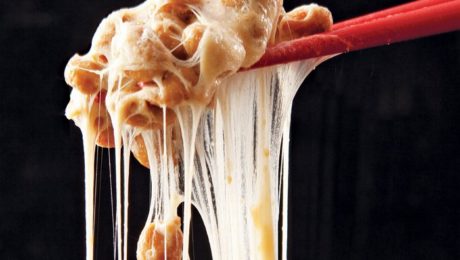FERMENTATION 2021 Wrap-Up
Nearly 300 individuals from around the world participated in The Fermentation Association’s first conference, FERMENTATION 2021. The virtual event included 35 educational keynotes, presentations, and panel discussions from more than 60 speakers over three days. Topics ranged from the science of fermentation to the art of fermenting to create flavor, from how fermented products are selling at retail to what’s next in the world of fermentation.
“I’ve been in this field for 40 years and, in all honesty, this is one of the biggest honors I’ve received, to be the speaker for this opening meeting of this really cool organization,” said Bob Hutkins, professor of food science at the University of Nebraska. Hutkins presented the conference’s opening keynote, Definition & History of Fermented Foods.
Over five years ago, John Gray, TFA’s founder, envisioned a trade show for producers of fermented foods and beverages, to make those artisanal items a more prominent part of the retail space. John connected with Neal Vitale, TFA Executive Director, and the organization was born out of their collective vision. TFA has grown, with a robust website, biweekly newsletter,a series of webinars and, now, an international conference. TFA has an Advisory Board that includes food and beverage producers, academics and researchers, and food and flavor educators and authors. TFA has formed working relationships with a number of other like-minded trade associations and organizations, and established a Buyers Council to create an active dialogue with food and beverage distributors, brokers and retailers.
“I have to tell you what a thrill it is to have you all here to witness and to participate in the beginning of a dream coming true,” added Gray in his welcoming remarks. Gray is the chairman and CEO of Katalina Holding Co., a food incubator and parent company of Bubbies Pickles.
FERMENTATION 2021 content paralleled TFA’s primary missions: first, help consumers better understand fermentation and its potential health benefits; second, work to improve health and safety regulations as they pertain to fermented products and third, connect the science and health research communities with producers, supporting scientific research and for a better understanding of the “state of the art.”
What made FERMENTATION 2021 unique is that it was the first event to bring together everyone involved in the world of fermentation — producers, retailers, chefs, scientists, authors, suppliers and regulators. The conference was not a how-to fermentation education event, as TFA feels there are numerous, effective resources for the person looking to, for example, make kimchi or learn about using koji.
“”We were delighted with how well FERMENTATION 2021 met — in fact, exceeded — our goals,” said Vitale. “While we were disappointed that the continuing impact of COVID-19 kept us from meeting in person, we were gratified by how all the participants responded, interacted, and engaged during our three jam-packed days. And, with recording of all our sessions now available online for our registrants, we expect that energy and excitement to continue.”,
“Fermentation is experiencing a major surge of interest in restaurants and kitchens around the globe,” says Amelia Nielson-Stowell, TFA Editor. “Our conference was a major milestone for the industry and we are already in the planning stages for FERMENTATION 2022 next summer. And, assuming we will be able to meet in person once again, we plan to host a tasting and sampling event for consumers alongside our conference.”
- Published in Business, Food & Flavor, Health, Science
Katz on Fermentation, Ancient & Modern
When Sandor Katz was asked to teach his first fermentation workshops in the early ‘90s, he figured it would have only niche appeal. Instead, people filled his workshops, begging for more information and calling on him to host similar events all over the U.S. “People [were] hungry for more information on fermentation,” he says.
“Humans didn’t invent fermentation. Fermentation is a natural phenomenon that existed before we did,” Katz says, speaking from in front of a wall of ferments and spices in his home kitchen in Tennessee. “Fermentation is an essential part of how people everywhere make effective use of whatever food resources are available to them. Food fermentation is not precious; fermentation is practical.”
Katz was a keynote speaker at the FERMENTATION 2021 conference. He shared his personal journey into the subject as well as his thoughts on fermentation as a natural phenomenon.
Fermentation as Trend
Katz says people are excited about fermentation for different reasons — some have memories of fermenting with their grandparents and want to try it at home, others are immigrants wanting to recreate dishes from their native countries, some are farmers hoping to preserve a surplus of produce, others are interested in the health benefits and some are foodies chasing the delicious flavor.
He hates equating fermentation with trends, preferring the term “fermentation revitalization” — the demographics of people currently making fermentation “trendy” again hasn’t really changed in the last 30 years.
“Fermentation has been so important to food traditions everywhere, and yet because of factory food production, one-stop shopping convenience foods, fewer and fewer people were practicing fermentation,” Katz said, recalling his workshops in the early days. “It was becoming more mysterious to people. Now there’s no denying that fermentation is trending. There’s a heightened awareness of fermentation, but people don’t realize the products of fermentation have been so integral to how everybody, everywhere eats. Without even thinking about fermentation, people have always been eating products of fermentation.”
The “War on Bacteria”
But there has long been fear around fermentation from some consumers. Katz says many people “project their anxiety about bacteria onto the idea of fermentation.”
“For people of my generation and older, we never heard anybody say anything positive about bacteria. The degree that bacteria were talked about at all, it was about how dangerous they are and how much they need to be avoided. I grew up in a period that could be described as the war on bacteria, this idea that bacteria are pathogenic, bacteria are dangerous to us, bacteria must be avoided and you know we have an arsenal of chemicals that we can use to kill bacteria as needed to keep us safe.”
The U.S Department of Agriculture has never had a case of foodborne illness from fermented food or beverages, Katz notes. “Statistically speaking, fermented vegetables are safer than raw vegetables.”
Facing people’s questions and fears motivated Katz to write his first book, The Art of Fermentation. This month, he released his 6th title, Fermentation Journeys: Recipes, Techniques, and Traditions from Around the World.
Fermenting the Future
Katz is an advocate for decentralizing food production, replacing a global supply chain with local, farm-fresh sources. Though this will raise the cost of food, it will put fermentation as a key means of preserving a surplus of seasonal crops, Katz notes.
Even as more and more chefs and producers apply different processes to different substrates and play with flavor, Katz says the fundamental processes remain the same. Nothing new has been invented in fermentation, which dates back 10,000 years.
“Fermentation of the future grows out of the techniques and traditions of the past,” he says. “Anything you can possibly eat can be fermented, so I’m never surprised when something is fermented.”
Katz shared his story of fermenting a goat on the rural Tennessee farm he lived on in the ‘90s. After the animal was butchered, he took the leftover pieces and fermented them for a few weeks in a mix of miso, yogurt and sauerkraut juice. When cooked, the meat released a strong aroma, a scent that became legendary on the farm. But, Katz says, “It was delicious. Like many things, it had a stronger aroma than flavor.”
Health Benefits Come with Warning Labels
When asked about the curative health benefits of fermented foods, Katz does not mince words. He wrote in Wild Fermentation that fermented foods were an important part of his healing when he was diagnosed with HIV in 1991. Since then, numerous media outlets have twisted his story, writing that Katz cured himself from HIV with fermented foods.
“I have become much more cautious about how I talk about this,” he says. “There’s a lot of highly speculative information out there…and I’ve never seen data that would suggest that.”
Katz says he’s careful to rely on reputable scientific studies for data on fermentation’s health benefits. He says he’s read articles claiming kombucha will prevent hair from going gray. Pointing to his full head of gray hair, Katz smiles and says “When I started teaching about fermentation, my hair didn’t look like this. Time marches on.”
“Food has profound implications for our health and well-being and for how we feel, but singular foods are very rarely the cure to specific diseases. …There are many benefits to fermentation, whether it is simply from pre-digestion of nutrients that makes nutrients more bioavailable and accessible to us or whether it’s from the probiotics or whether it’s from metabolic byproducts which can be extraordinarily beneficial to us.”
- Published in Food & Flavor
Food Technology’s “Gut Feeling”
Food Technology’s latest issue features an article entitled “Not Just A Gut Feeling” which details how and why more consumers are buying and making fermented foods and drinks. Spurred by the Covid-19 pandemic, there is growing interest in the gut microbiome and healthier food options.The curiosity around fermentation is buoying the retail category.
“It checks off all the boxes — artisanal, local, natural, sustainable, innovative,” says Bob Hutkins, food science professor of food science at the University of Nebraska–Lincoln (and a recent addition to TFA’s Advisory Board.) “People are making sourdoughs at home; they’re making kimchi at home; they’re going to kombucha bars. It’s definitely got the Gen Xers and the millennials intrigued.”
Included in the article are many insights from TFA — Advisory Board members Alex Lewin and Kheedim Oh, Executive Director Neal Vitale, and Editor Amelia Nielson-Stowell are all quoted.
Read more (Food Technology Magazine)
- Published in Business, Food & Flavor
The Next Frontier in Kitchen Appliances
Is fermentation the next big home kitchen technique? As more restaurants hire directors of fermentation, consumers are inspired to experiment at home.
An article in The Spoon makes a case for the rise of home fermentation equipment, which makes the process “a little less mysterious.”
“Fermenting is still viewed as something of a black art. Part of it is the weird and slightly creepy terminology (mother, anyone?). Mostly, though, it’s also because the act of farming bacteria to create tasty and healthy new foods is a far cry from the usual activity of assembling and cooking our meals in our kitchen.”
The article interviewed two entrepreneurs making their own fermentation devices: Breadwinner (which helps bakers know when their sourdough starter is ready) and Hakko Bako (a fermentation appliance). The creators say their products are making fermentation easy, controlled and approachable. Tommy Cheung of Hakko Bako notes food trends usually start in Michelin restaurants, then trickle down to casual dining and finally end up at the home kitchen. “I definitely think (home fermentation devices) are going to be a huge part of the future.”
Read more (The Spoon)
- Published in Business
Glenn Gibson Early Career Researcher Prize
Applications are being accepted for the 2022 Glenn Gibson Early Career Researcher Prize, sponsored by the International Scientific Association for Probiotics and Prebiotics (ISAPP). The winner will receive $1,500 U.S. cash and an invitation to present at the 2022 ISAPP annual meeting. Click here for application details, due Nov. 19.
In 2021, ISAPP launched the Early Career Researcher Prize. As this initiative was spearheaded by ISAPP co-founder and longtime board member Prof. Glenn Gibson, this award was renamed to honor him: “Glenn Gibson Early Career Researcher Prize”. The intent of this award is to recognize excellence in research in early career researchers in the fields of probiotics, prebiotics, synbiotics, postbiotics or fermented foods.
- Published in Science
How Important is Consumer Education?
This is the second in a series of articles that TFA will be releasing over the next few months, analyzing trends from our Member Survey.
Fermentation is cloaked in mystery for many consumers — it’s bubbly, slimy, stinky and not always Instagram ready.
So how can fermentation producers appeal to potential consumers? What’s the best way to share fermentation’s flavor and health attributes?
In The Fermentation Association’s membership survey on industry trends, a better-educated consumer was identified as a priority. When asked what would foster increased consumption of fermented foods and beverages, the top item for nearly 70% of producers was greater consumer understanding of fermentation and familiarity with the flavors associated with fermentation.
“More than wanting to sell a product, I want people to know the information,” says Sebastian Vargo of Vargo Brothers Ferments (who is speaking at FERMENTATION 2021). The Chicago-based brand sells ferments like pickles, sauces and kombucha. “I believe preventative health starts with fermentation. I’m explaining the difference between a pickle you see on the shelf versus a pickle you see in the refrigerator. But I’m also teaching people to power up their pantry, sauce up their life with condiments.”
Health vs. Flavor
Producers say they struggle sharing fermentation’s benefits with consumers. There are not enough peer-reviewed scientific studies on many fermented products to be the basis for health claims.
“We feel a responsibility as a fermented food company to entice customers into trying these hugely beneficial and delicious products,” says Savita Moynihan, who owns SavvyKraut in Brighton, UK, with her husband Stevo. But, “with sauerkraut, it is generally understood that raw and unpasteurised kraut is good for you but once you try to elaborate on live culture vs probiotics it gets complicated, more than it needs to be.”
Can a brand claim to include probiotics? Producers feel that guidance is not clear.
“There is confusion here that we feel needs to be ironed out in order to loosen the reins so fermenters can promote their products and their benefits with much more confidence,” she adds.
Moynihan says that, when SavvyKraut sells at farmers markets and local shops, they try to communicate two main things to consumers. First, the health benefits, like enhanced vitamin and nutrient contents, increased fiber and an aid to a diverse gut and digestive system. Second, the delicious flavor.
“The process of fermentation really enhances the flavours and creates an entirely new type of flavour which can elevate any meal,” Moynihan adds.
Lack of Tastings Hurting Efforts
One of the best ways to familiarize consumers with fermentation is for them to taste a product — flavor is a great marketing tool. But COVID-19 has hurt these efforts. Producers are unable to stage in-store demonstrations, offer samples at farmer’s markets or host in-person events. This has been especially hard for kombucha brewers, says Hannah Crum(who is also speaking at FERMENTATION 2021), president of Kombucha Brewers International (KBI).
“We still have such a big part of the population who don’t drink kombucha or don’t even know about [it]; we still have a lot of work in education,” Crum says.
Joshua Rood, CEO of Dr Hops Hard Kombucha, confirms, adding: “It continues to be very difficult to grow our brand and the whole category without live events.”
“The inability to do live tastings in 2020 had a significant diminishing impact on our sales during the pandemic,” he continues. “One of our main distinctions as a brand is superior taste. Consumers, however, do not believe claims about that unless they experience it for themselves. Even now we are significantly hampered by the lack of large beer festivals and street fairs. An artisanal craft brand like Dr Hops needs those live interactions!”
The Knowledge Gap
Despite the lack of in-store tastings, experts at New Hope Network (producers of the Natural Products Expos) say brands have a great opportunity — now, more than ever, during the COVID-19 pandemic — to connect with their consumers.
New Hope’s 2021 Changing Consumer Survey found U.S. consumers are not satisfied with their current health. Only 8% say they’re “extremely satisfied” with their health today, compared with 20% in 2017. Nearly 80% of consumers understand that diet greatly influences their health (79%). But achieving good health is both a goal and a struggle for consumers — and this is where brands can step in.
“There’s a gap to be bridged,” says Eric Pierce, vice president of business development for New Hope Network, during a session “Understanding Your Consumers” at the most recent Expo East. “I see it as our opportunity and our responsibility to help consumers translate healthy intentions into healthy behavior, either in how we’re educating them in our stores, the products that we’re innovating or the ways we’re communicating. Getting better at communicating can help them with solutions.”
A consistent, transparent, well-communicated message — from product label to social media page to website — is important. Pierce says consumers quickly see past “shallow marketing claims.”
“Leave a trail of breadcrumbs people can find,” Pierce advises. “You don’t have to communicate everything all at once, but allow people to follow a trail to the deeper story. When consumers want to find that trail, if it’s not there, they’ll quickly write you off as shallow with unbacked claims.”
Amanda Hartt, market research manager at New Hope, suggests putting a QR code on a product label that links to the science backing the benefits of your ingredients. Or partnering with a registered dietitian on social media to highlight how to use your product as part of a healthy diet.
[To learn more about this topic, register for FERMENTATION 2021 to hear one of the keynote panels “Educating Consumers About Fermentation.”]- Published in Business, Food & Flavor, Science
“A modern-day Johnny Appleseed”
GQ interviews “The Godfather of the Fermentation Revival,” Sandor Katz. In the Q&A, Katz shares how a cabbage surplus in his first garden turned into an obsession with fermentation. Katz teaches fermentation workshops and gives fermentation talks around the world (he will be speaking at FERMENTATION 2021). He’s also now the author of six books on fermentation, including the recently-published Fermentation Journeys.
The article says Katz “has become a globe-trotting mascot for the power of bacteria and yeast to create delicious food, a kind of modern-day Johnny Appleseed of tangy, savory flavors.”
Katz shares how he’s interested in learning more about the Chinese techniques for fermenting vegetables; he believes China is where fermenting vegetables in salt first originated. He also addresses his misquoted healing. Katz has lived with H.I.V for more than 30 years, but he says eating fermented foods does not cure AIDS. Katz does believe he’s never been sick from the antiretroviral drugs he takes to manage the disease because he eats fermented foods regularly.
Read more (GQ)
- Published in Food & Flavor
Jason White:“It’s Cool to be a Fermenter”
While more chefs and cooking enthusiasts are experimenting with fermentation, they’re skipping the basics and jumping straight to complicated dishes. The foundational steps of cooking are fine-tuned only with time and patience, with hours spent mastering the simple recipes first, according to Jason White, director of the fermentation lab at Noma restaurant.
“It’s just as important for you to make a delicious pickle and a wonderfully balanced kombucha as it is for you to make an incredibly long-aged batch of miso,” White says. “We can never forget that, whenever we start approaching these biological processes and these fermentation processes, that we also take advantage of the beginning stages of learning each individual step along the way. I can’t tell you how important it is for a person who’s emerging into the art of fermentation to stop and pause for a minute and take the opportunity to connect dots. Each microbe that we’re using to ferment things has some kind of mechanism, and an ingredient that we’re going to ferment has a composition that benefits that microbe.”
White spoke at Harvard University’s Science & Cooking Lecture Series, on the topic Fermentation: A Springboard for Modern Gastronomy. He began his director role at Noma last year and has since helped the world-famous restaurant earn its third Michelin star in September.
In his lecture, White stressed observational skills — honed in the early years of learning to ferment — are one of the most important qualities for a fermenter. The best way to “really understand what an ingredient is and what it has to offer a microbe” is through the senses. When you cut into the ingredient, does it feel dry? Does it smell of essential oils? Does it taste overripe?
“Fermentation is one of those weird occurrences in nature where humans intentionally create something only to watch it decompose, and when it decomposes it produces something that’s more valuable to us,” White says. “I am not a chef, I am not a scientist, I am a dreamer and I am a fermenter and my life journey is going to be dedicated to the act of microbial processing.”
From Texas to Denmark, Fermenting with Local Agriculture
A native of Albuquerque, New Mexico, White began a career as a fermentation consultant for restaurants and distilleries in Texas. He worked for two years at Noma before returning to the U.S. in 2019 as head of the food research lab at Audrey restaurant in Nashville.
The early days of his career in gastronomy weren’t spent in beautiful, state-of-the-art kitchens like those at Noma. White’s first experiences as a professional fermenter were spent cooking in a small wooden shed in the Texas heat.
Environment is a critical element to fermenting. Texas is vastly different from the areas that are the globe’s cornerstones of fermentation — Japan, Korea and Taiwan — and which had inspired White. Texas, for example, doesn’t have a huge variety of mushrooms or produce — but it does have chilies and lots of grains.
“I found a lot of joy adapting traditional recipes into something that was based off Texas agriculture,” White says. Much of his fermentation in those days was driven by koji, which grows well on the grains common to Texas.
White learned a key lesson that he incorporates in his cooking: use the local ingredients and agricultural systems available in the area.
“Every single ingredient on earth, you’re going to find something that is valuable to a fermentation process,” White adds. “Even if we can’t consume it as humans, you can use the fermentation process to make it more delicious.”
Respecting the Past, Propelling the Future
Fermentation has been around since the beginning of humanity. When we ferment, White says, we’re recreating the environment and the processes traditionally used where the ferment was first discovered and practiced.
“And, as fermenters, we are also carrying the knowledge of these practices through the generations,” White says. “And where we are with fermentation, it’s kind of like emergent pop cultures. It’s cool to be a fermenter.”
White characterizes his fermentation style as “somewhere between a control freak and a naturalist.” Fermenters have a “huge sense of responsibility” to maintain food safety, carry on traditional processes and teach new fermenters. …We are protectors of knowledge, we are protectors of ingredients and we are protectors of history.”
Whether fermenting at home for personal use or in a production facility for consumers, “We are all still changing the way microbes are evolving and we’re all still participating in the ancient act and it is truly beautiful….if anyone in this room wants to ferment, you are literally the future of fermentation.”
During his presentation, White demonstrated how to ferment persimmons. In Texas, local farmers would bring persimmons to the restaurant where he worked. They were hard and unripe, not flavorful enough to eat raw, so White soaked them in amazake, a fermented rice beverage. During his lecture, White sliced bright orange persimmons for an amazake bath.
“The beauty in this whole entire thing isn’t how complex it is,” White says. “Fermentation doesn’t have to blow your mind, you don’t have to be like ‘Oh my god, it’s completely transformed, it’s something I don’t even recognize and it makes my palate explode with flavor.’ No. Fermentation could also be something that respects an ingredient and leaves it as is. But enhanced fermentation is something that can make something that is not as valuable as it should be more valuable again. You can turn something that would maybe go in the trash…into something very delicious.”
- Published in Food & Flavor
The Stickier the Natto, the Better
Natto significantly lowers levels of both glucose and insulin, according to research by Japan’s National Agriculture and Food Research Organization. Natto, a traditional food in Japan, is a fermented soybean dish valued for its high-nutrient content. It’s characterized by sticky strands that stretch from the dish when stirred and, the research showed, stickier natto is healthier.
Natto’s stringy texture is produced by y-polyglutamic acid (y-PGA), and stickier natto has higher levels of y-PGA. When nondiabetic men and women were fed a series of meals of both high-and low-y-PGA natto, high y-PGA natto “significantly” lowered glucose and insulin levels in the test subjects.
Study results were published in the scientific journal Nutrients. Researchers next hope to “study the long-term health impacts of a diet that includes high γ-PGA natto.”
Read more (Chemical & Engineering News)


